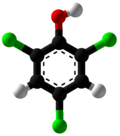2,4,6-Trichlorophenol
 |
|||
|
|
|||
 |
|||
| Names | |||
|---|---|---|---|
|
IUPAC name
2,4,6-Trichlorophenol
|
|||
| Identifiers | |||
|
3D model (Jmol)
|
|||
| ChEBI | |||
| ChemSpider | |||
| ECHA InfoCard | 100.001.633 | ||
| EC Number | 604-018-00-5 | ||
| RTECS number | SN1575000 | ||
| UN number | 2020 | ||
|
|||
| Properties | |||
| C6H2Cl3OH/C6H3Cl3O | |||
| Molar mass | 197.45 g/mol | ||
| Appearance | yellow-whitish lumps or powder | ||
| Density | 1.675 g/cm3 | ||
| Melting point | 69 °C (156 °F; 342 K) | ||
| Boiling point | 246 °C (475 °F; 519 K) at 28 torr | ||
| Hazards | |||
| R-phrases | R22, R36, R38, R40, R50, R53 | ||
| S-phrases | (S2), S36, S37, S60, S61 | ||
|
Except where otherwise noted, data are given for materials in their standard state (at 25 °C [77 °F], 100 kPa).
|
|||
|
|
|||
| Infobox references | |||
2,4,6-Trichlorophenol, also known as TCP, phenaclor, Dowicide 2S, Dowcide 2S, omal, is a chlorinated phenol that has been used as a fungicide, herbicide, insecticide, antiseptic,defoliant, and glue preservative. It is a clear to yellowish crystalline solid with a strong, phenolic odor. It decomposes on heating to produce toxic and corrosive fumes including hydrogen chloride and chlorine.
In animal models, consumption of 2,4,6-trichlorophenol leads to an increased incidence of lymphomas, leukemia, and liver cancer. It is classified as Group B2 (probable human carcinogen) by the United States Environmental Protection Agency. The technical grade of this substance may contain polychlorinated dibenzodioxins (PCDDs), polychlorinated dibenzofurans (PCDFs), and other contaminants.
2,4,6-Trichlorophenol is an environmental pollutant that has been found in fresh water lakes such as the Great Lakes.
...
Wikipedia


